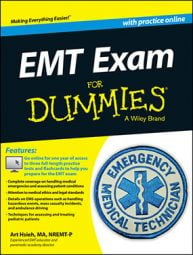The EMT cognitive exam is what most students call the “written exam.” It covers all the information you spent a few months learning in class. However, the exam isn’t just about remembering facts and figures; it’s more about how to apply that information to “real life” situations.
You take the cognitive portion of the EMT exam on a computer at a testing center. Doing so allows for greater accuracy in determining your level of comprehension of the material.
The NREMT EMT exam is broken down into the five content areas. The breakdown of the percentage of questions for each content area varies slightly. Within each area, 85 percent of the questions are geared toward adult patients and 15 percent toward pediatric patients.
| Content Area | Percentage of Exam Content |
|---|---|
| Airway, Respiration, and Ventilation | 17–21% |
| Cardiology and Resuscitation | 16–20% |
| Medical and Obstetrics/Gynecology | 27–31% |
| Trauma | 19–23% |
| EMS Operations | 12–16% |
These five areas may not correspond directly to how your class covered the information. However, the following gives you a general idea of how the information is broken down on the test.
Airway, respiration, and ventilation
The airway, respiration, and ventilation category covers the following topics:
Airway management
Respiratory emergencies
Primary assessment
Human anatomy and physiology related to the airway and breathing
Cardiology and resuscitation
The following three topics are integral to the cardiology and resuscitation portion of the test:
Anatomy and physiology related to cardiology and the vascular system
Cardiac arrest
Shock
Medical and obstetrics/gynecology
Medical, obstetrics, and gynecology are combined into one broad category. Following are the topics you should be versed in for this portion of the test:
Neurologic emergencies
Gastrointestinal emergencies
Urological emergencies
Endocrine emergencies
Hematologic emergencies
Immunologic emergencies
Infectious diseases
Toxicology
Psychiatric emergencies
Gynecologic emergencies
Obstetrics and neonatal care
Nontraumatic musculoskeletal disorders
Anatomy and physiology related to each system listed
Secondary assessment related to medical patients
Reassessment of trauma patients
Trauma
Trauma-related topics that you need to be familiar with include the following:
Bleeding
Chest trauma
Abdominal and genitourinary trauma
Orthopedic trauma
Soft tissue trauma
Head, facial, neck trauma
Spine trauma
Environmental emergencies
Multisystem trauma
Anatomy and physiology related to each system listed
Secondary assessment related to trauma patients
Reassessment of trauma patients
EMS operations
The EMS operations portion of the test goes beyond patient care to address such issues as medical legal standards, emergency vehicle operation, environmental hazards, and incident management. Topics to bone up on for this portion of the test include the following:
EMS systems
EMT safety and wellness
Communications and documentation
Therapeutic communications
Medical legal concepts and ethics
Ambulance operations
Incident management
Multiple casualty incidents
Hazardous materials
Terrorism and disasters
Within each of these areas, about 15 percent of the questions are based on pediatric patients, and the remaining 85 percent focus on adult and geriatric patients.

